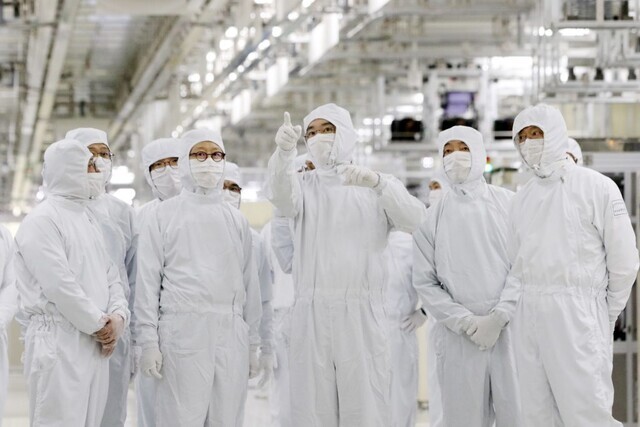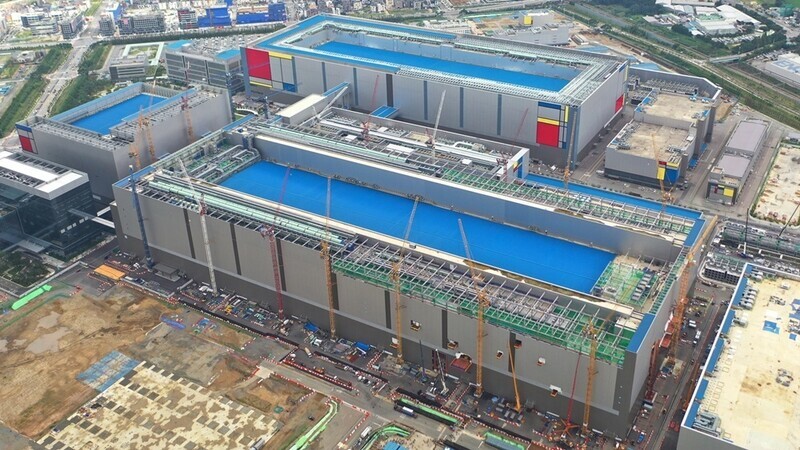hankyoreh
Links to other country sites 다른 나라 사이트 링크
Why semiconductor powerhouse Korea is sounding the alarm about its domestic industry

The past five years have seen Korea’s memory chip exports fall by half, from US$83 billion in 2018 to US$42.9 billion in 2023. The decrease has been the most pronounced in the last two years, with double-digit export declines each year. Despite domestic semiconductor companies maintaining a near monopoly on the global memory chip market, with companies such as Samsung Electronics and SK Hynix holding 60% of the market share for more than a decade, we are witnessing a plummet in exports.
Experts say the past two years have exposed the weaknesses inherent in the structure of the memory-centric domestic semiconductor industry, which is far too influenced by the status of the industry as a whole.
South Korea has minimal influence in the non-memory chip market, which demonstrates relatively stable growth. Data from the Korea Institute for Industrial Economics and Trade shows that South Korea’s non-memory chip market share (by revenue) is at 3.3%, lagging far behind Taiwan (10.3%), Japan (9.2%), and China (6.5%). The US is leading the way, due to its strength in the chip design sector, at 54.5%.
Memory accounts for 23.88% of the global semiconductor market (187 trillion won) while non-memory accounts for 76.12% (593 trillion won), showing how South Korea has a strong presence in a tiny market.
Trials in expanding business to non-memory
Alarms have been ringing at an industry level in part due to the situation at Samsung Electronics, the semiconductor powerhouse that has been leading the country’s semiconductor industry. Those within the company's Device Solutions department and outside observers are expressing concern, warning that Samsung is facing trouble.
Samsung, which utilized a strategy that enabled it to quickly dominate the general-purpose chip market through large-scale investment, is not coping well with the new horizon of the semiconductor industry brought along by artificial intelligence, which borders on on-demand production.
This can be demonstrated by inspecting the supply of high-bandwidth memory (HBM) chips, which fall under the mainstream D-RAM category. HBM, which is essential for graphics processing units (GPUs) for artificial intelligence servers, has seen a sharp increase in demand since 2023 due to the craze stirred by ChatGPT. However, Samsung has been unable to supply it to Nvidia, which has a monopoly on GPUs since the fourth-generation HBM3 due to packaging-related technical issues. SK Hynix, which has been following Samsung’s tail, has now virtually monopolized the supply.
Lee Seung-woo, the director of research at Eugene Investment and Securities, said, “In the era of artificial intelligence, customized technologies such as packaging are becoming more important, but Samsung’s competitiveness is slipping. There are technical issues not only in HBM but also in double data rate (DDR), so there is an unprecedented feeling of growing crisis within Samsung.”
Samsung’s dismantling of its HBM development team in 2019 is seen as an example of the company’s failure to anticipate future trends. A semiconductor industry insider who requested anonymity said, “Samsung, which had been dominating the market until the HBM2 product, disbanded its HBM development team in 2019, citing unguaranteed profitability. The choice was made to respond to the business downturn at the time, but this short-term strategy failed to determine future trends, resulting in the company struggling in the early stages of the AI chip market.”
In the non-memory field, the company has been embarking on new challenges over the past few years, but is still trailing way behind its competitors.
Taiwan’s TSMC, the No. 1 player in the non-memory chip foundry market, has secured large customers such as Apple, Nvidia, and AMD to solidify its position at the top of the pack. Samsung, on the other hand, has failed to woo clientele of the same caliber.
Samsung is holding on to second place in the market thanks to its strategy of producing its own chips for home appliances and smartphones as well as breaking off some of the business that’s headed toward TSMC.
However, Intel’s recent decision to re-enter the foundry business is threatening to push Samsung from that position. According to market research firm TrendForce, TSMC held a 61.2% share of the global foundry market in the final quarter of 2023, while Samsung Electronics held 11.3%. Compared to the third quarter of 2023, Samsung’s share decreased by 1.1 percentage points, while TSMC's share increased by 3.3 percentage points, widening the gap.
“Samsung’s gate-all-around (GAA) process, which was introduced at 3 nanometers, is failing to win over customers due to low yields,” Lee said. At this rate, the view that Samsung Electronics Chairperson Lee Jae-yong may not be able to achieve his goal of investing 133 trillion won by 2030 to become the world’s No. 1 system semiconductor (both design and foundry fields) company is prevailing within the market.
In the AP field, the system chip that functions as the brain of smartphones, Samsung increased its market share to 16.3% in 2018 (No. 2 globally), but it fell back to 7.6% in 2023 (No. 3). This marks a reversal of the growth trend that started from 2.4% in 2015.

An age of competition over industrial policy
The arrival of what has been called the "geoeconomic era," in which countries employ economic methods for national security purposes, entails new challenges for the Korean semiconductor industry, including Samsung Electronics. Importantly, semiconductors are in an economic boom as major countries and industries rush into the expanding field of AI. The simultaneous development of generative AI, autonomous driving and on-device AI has brought along ballooning demand for the requisite chips.
“OpenAI CEO Sam Altman’s plan to raise an astronomical sum of money to build a chip supply chain for AI signifies that there’s a huge amount of latent added value in the AI industry. Moves by platform companies like Amazon and Google to design their own chips for standout AI services could lead them to order more chips from SK Hynix [custom-order memory chips] and Samsung Electronics [foundry and memory chips],” said Choi Do-yeon, the head of the research center at SK Securities.
Samsung Electronics’ foundry division may have an ace up its sleeve. Since Samsung began applying gate-all-around (GAA) technology with its 3 nm chips, it may have a competitive advantage in terms of yield over TSMC, which only started applying GAA technology to its 2 nm chips.
“Samsung is applying third-generation GAA technology to 2 nm chips, which is likely to be superior in terms of performance and power efficiency to TSMC’s first-generation GAA technology. Samsung is expected to receive more orders for its cutting-edge 2 nm line, which would enable it to compete on a technological level with TSMC,” said Kim Dong-won, an analyst at KB Securities.
US controls on the exports of semiconductor technology are also hobbling China’s development of cutting-edge technology. The Chinese government has been investing huge amounts of money into Chinese companies to spur growth in the semiconductor industry and play catch-up with Korean companies. Even so, controls on equipment exports have given Samsung Electronics and SK Hynix extra time to increase their technological lead.
In this context, the Korean government has released a plan to create the world’s largest semiconductor cluster in southern Gyeonggi Province by 2047. The plan is for Samsung Electronics and SK Hynix to invest 622 trillion won and for the government to provide tax benefits; build infrastructure, including access to power and water; and support worker training.
The government expanded tax credits for semiconductor investment to 25% last year while more than doubling this year’s budget for supporting the semiconductor industry (1.3 trillion won) from last year. The government believes that such assistance, when combined with the resources of a company that has become the global leader in memory semiconductors, may be enough to keep Korean companies from falling behind in the chip war.
That said, external factors could always come back to haunt the industry. As major chipmaking countries and regions including the US, Japan, China and Taiwan jump into the strategic competition for semiconductor factories, it is impossible to predict what changes the market may undergo over the next few years.
A survey by Semiconductor Equipment and Materials International of cutting-edge 12-inch (300 mm) wafer semiconductor factories that are being built in various countries between 2022 and 2026 found that 25 are under construction in China, 14 in the US, 13 in Taiwan, 9 in the EU (including Israel) and 8 in Japan.
“Countries that are major producers of semiconductors are promoting policies of building domestic semiconductor ecosystems through government subsidies, which could weaken the competitiveness and status of the Korean semiconductor industry,” said Jeong Hyung-gon, a senior researcher at the Korea Institute for International Economic Policy.
“So much money is being pumped into the semiconductor industry that there are concerns about overinvestment. That could lead to another period of intense competition in two or three years. We need to prepare for future issues of oversupply and concerns that large numbers of Korean semiconductor workers could move to the US when new factories open there,” said Burm Jin-wook, a professor of system semiconductor engineering at Sogang University.
By Ock Kee-won, staff reporter; Kim Hoe-seung, senior staff writer
Please direct questions or comments to [english@hani.co.kr]

Editorial・opinion
![[Column] Season 2 of special prosecutor probe may be coming to Korea soon [Column] Season 2 of special prosecutor probe may be coming to Korea soon](https://flexible.img.hani.co.kr/flexible/normal/500/300/imgdb/original/2024/0426/3317141030699447.jpg) [Column] Season 2 of special prosecutor probe may be coming to Korea soon
[Column] Season 2 of special prosecutor probe may be coming to Korea soon![[Column] Park Geun-hye déjà vu in Yoon Suk-yeol [Column] Park Geun-hye déjà vu in Yoon Suk-yeol](https://flexible.img.hani.co.kr/flexible/normal/500/300/imgdb/original/2024/0424/651713945113788.jpg) [Column] Park Geun-hye déjà vu in Yoon Suk-yeol
[Column] Park Geun-hye déjà vu in Yoon Suk-yeol- [Editorial] New weight of N. Korea’s nuclear threats makes dialogue all the more urgent
- [Guest essay] The real reason Korea’s new right wants to dub Rhee a founding father
- [Column] ‘Choson’: Is it time we start referring to N. Korea in its own terms?
- [Editorial] Japan’s rewriting of history with Korea has gone too far
- [Column] The president’s questionable capacity for dialogue
- [Column] Are chaebol firms just pizza pies for families to divvy up as they please?
- [Column] Has Korea, too, crossed the Rubicon on China?
- [Correspondent’s column] In Japan’s alliance with US, echoes of its past alliances with UK
Most viewed articles
- 1‘We must say no’: Seoul defense chief on Korean, USFK involvement in hypothetical Taiwan crisis
- 2Why Kim Jong-un is scrapping the term ‘Day of the Sun’ and toning down fanfare for predecessors
- 3Two factors that’ll decide if Korea’s economy keeps on its upward trend
- 4After election rout, Yoon’s left with 3 choices for dealing with the opposition
- 5BTS says it wants to continue to “speak out against anti-Asian hate”
- 6AI is catching up with humans at a ‘shocking’ rate
- 7Noting shared ‘values,’ Korea hints at passport-free travel with Japan
- 8Gangnam murderer says he killed “because women have always ignored me”
- 9South Korea officially an aged society just 17 years after becoming aging society
- 10Ethnic Koreans in Japan's Utoro village wait for Seoul's help